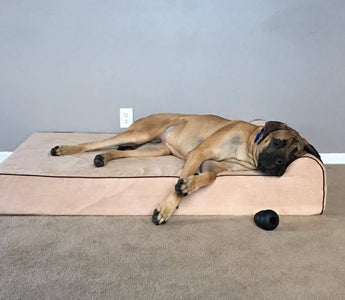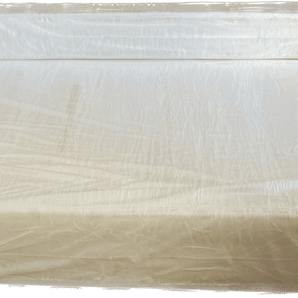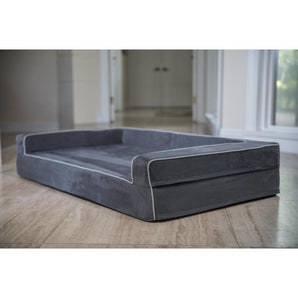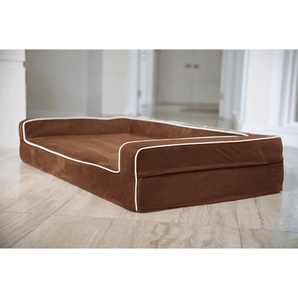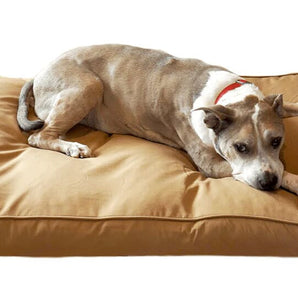If you have a dog with hip dysplasia, you know firsthand just how painful this condition can be. And nothing breaks a pet owner's heart more than seeing their companion in pain.
Keeping your dog comfortable if they're suffering from hip dysplasia can be a challenge. But one of the best things that you can do for them is investing in an orthopedic dog bed.
In this article, we'll go over how to choose the best dog bed for hip dysplasia. Selecting the right bed can greatly improve your pup's quality of life.
We'll also go over the details of canine hip dysplasia so you can fully understand this condition. You'll also learn how to catch it early if it happens to occur in your dog, so keep reading for information every dog owner needs to know.
What Is Canine Hip Dysplasia?
Canine hip dysplasia is a common skeletal disorder in dogs. It is characterized by a malformation of the ball and socket of the hip joint.
If the ball and socket do not develop properly, they rub and grind against each other instead of sliding smoothly. The joint does not function properly and thus deteriorates over time, leading to pain and arthritis.
There are both genetic and environmental factors that play a role in the development and progression of canine hip dysplasia.
Big dogs are more genetically susceptible to hip laxity, which is a loose fit of the hip joint. Some of the large breeds that are most commonly affected include German Shepherds, Golden Retrievers, Great Danes, Saint Bernards, and Labrador Retrievers. Rapid weight gain, obesity, and improper nutrition can also cause hip dysplasia.
Symptoms of hip dysplasia depend on the degree of joint looseness and inflammation. The duration of the disease also plays a significant part in what signs you may notice.
Dogs with hip dysplasia may have difficulty rising or may seem reluctant to run, jump, climb stairs, etc. This is due to hip pain, stiffness, and decreased range of motion.
You might also observe your dog limping or "bunny hopping" when running. Other signs include abnormal sitting positions, trouble standing for long periods of time, and cracking or popping sounds from joints.
Hip Dysplasia in Dogs: The Ultimate Guide (2021)
Fortunately, there are a wide variety of options to help manage the symptoms of canine hip dysplasia. Physical therapy such as swimming or motion exercises are recommended to decrease joint stiffness and strengthen muscles. Weight loss and diet management also help take the stress off your dog's joints.
One of the best things that you can do to help your dog manage their symptoms is to get them an orthopedic dog bed.
How Orthopedic Dog Beds Help With Hip Dysplasia

Investing in an orthopedic dog bed is a great way to help your dog manage symptoms of hip dysplasia.
This disease doesn't affect the hip joint alone. Your dog overcompensates for the pain and lack of function.
That means that hip dysplasia takes a toll on your dog's entire body. Their other joints begin to ache and their muscles get fatigued.
Orthopedic dog beds relieve the pressure point on your dog's joints. Good ones are made of memory foam that is specifically designed to take pressure off the joints.
Memory foam dog beds help dogs the same way it helps humans. It becomes soft enough to mold around a person or dog's body shape. This provides specialized support to the areas that need it most.
Canine hip dysplasia often leads to a decrease in your dog's activity levels. That means they're going to spend a lot more time resting in bed.
This is why it's so important to select a bed with high-quality memory foam when you are choosing a dog bed. Low-quality memory foam loses its shape over time and does not hold up under constant use. They can also exacerbate hip dysplasia pain by providing inadequate support.
An orthopedic dog bed is an investment that should provide your dog comfort for a lifetime. This is why it's so important to take the time to choose the right bed for your dog. And Bully Beds helps make the decision easy for you -- we provide the highest quality beds that help your dog live a more comfortable life.
How to Choose the Best Dog Bed for Hip Dysplasia
When it comes to orthopedic dog beds, the options can be overwhelming. But if you know what to look for and how to choose, the process becomes much simpler. Let's break down how to choose a dog bed that will help relieve symptoms associated with hip dysplasia.
Size Matters
Although large and giant dog breeds are the most vulnerable to hip dysplasia, the disease can occur in any dog. Senior dogs that are small and medium in size can also experience the same joint pain and reduction of function.
This is why the first thing you need to take into account is the size of your pup. Orthopedic beds are designed to help a specific dog size.
A golden retriever won't fit on a bed made for small dogs. But at the same time, a dachshund won't get the support it needs on a bed made for giant breeds.
If you have a small breed, buy a dog bed for small dogs. If you have a large breed, buy a dog bed for large dogs.
If you are unsure about sizing, measure your dog when they are lying down or sleeping. Measure both from nose to tail, and from paw to shoulder. These dimensions will be your guide when selecting an orthopedic bed.
How Does Your Dog Like to Sleep?
Every dog has a particular sleeping position that they are most comfortable in. Next time that your dog is sleeping, take note of what position they're in.
If your dog likes to sleep with their legs stretched out, make sure you select a bed that has enough space on all sides. For these types of sleepers, choosing a slightly larger bed is always a good option. This ensures that your pup has enough room to move around and get comfortable.
If your dog likes to curl up, choose a rounded bed with raised sides. This gives them something to snuggle up against that helps them feel safe and secure.
Some breeds, especially ones that were bred to dig and burrow, might prefer sleeping underneath a blanket. If this is the case, observe the general positioning of their body under the blanket and select a bed that caters to it.
Then, make sure to leave their favorite blanket on top of the new bed. This will encourage them to snuggle up on the memory foam.
This is a good idea for getting any dog used to a new bet. If they slept with anything in their old bed, transfer it to the new one. You can also use a favorite toy or treats to persuade them to check it out.
Your Dog's Range of Motion
As we covered above, hip dysplasia impacts your dog's range of motion. This makes it hard for them to rise from sitting or lying positions. It also makes it challenging to get up and down from elevated surfaces.
Take this into consideration when choosing a bed. The last thing you want is to cause your dog extra pain when they are getting in and out of bed. But an extremely flat dog bed is also no better than sleeping on the floor.
The best thing to do is watch how your dog gets up and down from slightly elevated surfaces. Try to determine the maximum height that they are comfortable moving up and down from. Then, compare that height to the height of the dog bed.
If they need extra help, use a doggie step to help them transition from the floor to the bed. The biggest thing to do is keep your dog's overall comfort in mind.
Waterproof Beds
Waterproof beds are excellent for senior dogs. As your dog ages, its bladder can weaken and thus fail more often.
If this is an issue that your dog faces, it's a great idea to get them a waterproof bed. This protects overnight accidents from soaking into the memory foam.
You have a few options when it comes to cleaning these beds. For small accidents, you can just wipe down the surface and leave it to dry.
You can also take the waterproof cover off the bed and washed in a washing machine. This tackles smells, stains, and extends the bed's lifespan.
The Infrared Dog Bed
If you want to get your pup the best of the best, there is no better bed for treating hip dysplasia in dogs than Bully Beds' Infrared Dog Bed. This is one of the best dog beds for large dogs on the market today. It is the first and only dog bed that has an FDA medical device certification.
Bully Beds' Infrared Dog Bed uses your dog's body as its power source to provide warmth and comfort. Your dog's body naturally emits far-infrared rays. These FIR emissions are reflected by the bedding's ceramic-coated fibers.
The reflection of these rays dilates blood vessels and increases blood circulation. It also enhances tissue oxygen levels. Both of these effects provide pain relief to dogs struggling with hip dysplasia.
The FIR emissions are absorbed deep into your dog's tissue. This provides reduction of discomfort, increased recovery time, and even increased energy.
The fabric of the bed reflects the FIR emissions and allows excess heat to escape. This moderates sleep temperature and keep the bed from being too hot.
You can compare the benefits of this bed to the benefits of sleeping with a heating pad or heated blanket. The extra warmth and heat reflection create a calming effect as it encourages blood flow and raises tissue oxygen levels. This is why heating pads can help soothe muscle and joint pain in humans.
The Infrared Dog Bed works the exact same way for your dog. If your large dog is suffering pain from hip dysplasia, there is no better bed on the market for them.
The Original Bully Bed
The original Bully Bed is designed specifically for hip dysplasia support. The CertiPUR-US certified memory foam base provides joint and hip support to reduce discomfort caused by hip dysplasia.
The seven-inch raised section acts like a pillow and provides further spine support. The microfiber cover is easily removable and machine-washer safe. It's the perfect bed for great danes, mastiffs, and other large dog breeds.
Orthopedic 3 Sided Bolster Bed
If your dog likes to snuggle or lean against the sides of their bed, our 3 Sided Bolster Bed is the perfect option. It's designed just like the original Bully Bed, with the added feature of memory foam bolsters on three sides.
The bed is made with non-toxic and hypoallergenic materials. The memory foam is free from PBDEs, mercury, lead, heavy metals, formaldehyde, phthalates, and CFCs.
It's the perfect bed for large breeds that need extra hip and joint support.
Calming Faux Fur Round Bed
This round bed is designed with the softest faux fur on the market today. It stays cool, even during warm summer months. Your pup will love the smooth feel of the fur and the supportive foam.
The bed is designed in a deep doughnut style with bolsters ringing the entire outside. This provides a secure place for your dog to relax and feel safe.
The Calming Faux Fur Bed is our softest bed yet. The memory foam provides support for hips and joints while maintaining perfect softness. It's the perfect choice for dogs that prefer a softer bed or have trouble with canine anxiety.
Reducing Pain with Orthopedic Dog Beds
Hip dysplasia is a serious and painful disease. But symptoms can be treated with proper veterinary care and the use of an orthopedic dog bed.
Bully Beds provides a plethora of options to help treat your dog's hip dysplasia, including the Infrared Dog Bed and the Original Bully Bed - two of the best dog bed for hip dysplasia on the market today.
If your dog is suffering from hip dysplasia, check out our full line of orthopedic dog beds. We have options to cater to every type of dog and sleeping style. Help reduce your pup's pain today.
